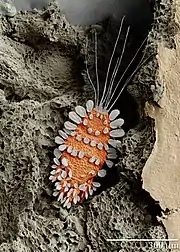| Tuckerella Temporal range: | |
|---|---|
 | |
| False-colour scanning elecron micrograph of Tuckerella sp., magnified 260 times | |
| Scientific classification | |
| Domain: | Eukaryota |
| Kingdom: | Animalia |
| Phylum: | Arthropoda |
| Subphylum: | Chelicerata |
| Class: | Arachnida |
| Order: | Trombidiformes |
| Superfamily: | Tetranychoidea |
| Family: | Tuckerellidae Baker & Pritchard, 1953 |
| Genus: | Tuckerella Womersley, 1940 |
The peacock mites of the genus Tuckerella (the only genus of the mite family Tuckerellidae) are a significant herbivorous pest in the tropics, for example on citrus fruit. Other species dwell in grasses, possibly as root feeders.[1]
The peacock mite's name suggests that their feather-like (or leaf-like) setae[1] adorning their backs are evocative of a peacock's plumage.[2] They also have long hair-like setae projecting from rear (caudal setae)[3] that have been compared to a trailing peacock tail.[1] The 5–7 pairs of caudal setae can be flicked over the body very quickly,[1] so they are used like whips in defense against predators.[2] They may also help in wind-borne dispersal.[2]
They are classified in the superfamily Tetranychoidea,[4] being its most ornate members.[1]
Species
- Tuckerella anommata Smith-Meyer & Ueckermann, 1997 (South Africa)
- Tuckerella channabasavannai Mallik & Kumar, 1992 (host: Saraca indica; Andhra Pradesh)
- Tuckerella eloisae Servin & Otero, 1989 (host: Fouquieria diguetii; Mexico)
- Tuckerella filipina Corpuz-Raros, 2001 (host: Hydnocarpus sp.: Philippines)
- Tuckerella hainanensis Lin & Fu, 1997 (host: Coffea arabica; Hainan)[5]
- Tuckerella jianfengensis Lin & Fu, 1997 (host: Annona muricata; Jianfengling, Hainan)[5]
- Tuckerella kumaonensis Gupta, 1979 (India)
- Tuckerella litoralis Collyer, 1969
- Tuckerella nilotica Zaher & Rasmy, 1970 (Egypt)
- Tuckerella ornatus (Tucker, 1926) – type species[6]
- Tuckerella xiamenensis Lin, 1982 (host: Manilkara zapota)
- Tuckerella xinglongensis Lin-Yanmou & Fu-Yuegua, 1997 (hosts: Polyscias fruticosa var. plumata and Camellia sinensis; Hainan)[5]
- †Tuckerella fossilibus Khaustov, Sergeyenko & Perkovsky 2014 (Rovno amber)[7]
- †Tuckerella weiterschani Sidorchuk & Khaustov, 2018 (Baltic amber)[8]
References
- 1 2 3 4 5 Walter, David Evans; Proctor, Heather (2013). Mites: Ecology, Evolution & Behaviour. Springer Science & Business Media. p. 292. ISBN 978-94-007-7164-2.
- 1 2 3 D.E. Walter (University of Queensland) (2005-09-28). ""Peacock mites" Tuckerellidae". United States Department of Agriculture.
- ↑ Vacante, Vincenzo (2010). Citrus Mites. Cabi. p. 167. ISBN 978-1-84593-499-6.
- ↑ David Evans Walter (2004). "Hidden in plain sight: mites in the canopy". In Margaret Lowman & H. Bruce Rinker (ed.). Forest Canopies. Academic Press. pp. 224–241. ISBN 978-0-12-457553-0.
- 1 2 3 Zhang, Zhi-qiang; Hong, Xiao-yue; Fan, Qing-hai (2010). Progress in Chinese Acarology. Magnolia Press. p. 7. ISBN 978-1-86977-545-2.
- ↑ "Index of the Described Animalia of the World: Tuckerellidae". Texas A&M University.
- ↑ A.A. Khaustov; A.L. Sergeyenko; E.E. Perkovsky (2014). "First fossil record of mites of the family Tuckerellidae (Acari: Tetranychoidea) from Rovno amber with description of a new species". International Journal of Acarology. 40 (5): 367–369. doi:10.1080/01647954.2014.933253. S2CID 84956169.
- ↑ Ekaterina A. Sidorchuk; Alexander A. Khaustov (2018). "Two Eocene species of peacock mites (Acari: Tetranychoidea: Tuckerellidae)". Acarologia. 58 (1): 99–115. doi:10.24349/acarologia/20184228.
External links
 Data related to Tuckerella at Wikispecies
Data related to Tuckerella at Wikispecies
